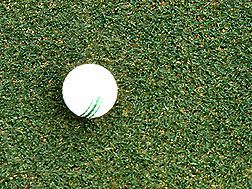This page has been archived and is being provided for reference purposes only. The page is no longer being updated, and therefore, links on the page may be invalid.
| Read the magazine story to find out more. |
|
|
|
|
Keeping the Green in Putting Greens
By Dennis O'BrienJune 21, 2012
When a patch of unwanted grass discolors a putting green, it can cause headaches for golf course managers and for the sod farmers who supply them. But a U.S. Department of Agriculture (USDA) scientist has developed a tool to help minimize the damage.
Putting greens in the southern United States are made up of single cultivars of bermudagrass, and the appearance of non-uniform plants, or "off-types," can throw off the green's appearance and "playability." Karen Harris-Shultz, a geneticist with the Agricultural Research Service (ARS) Crop Genetics and Breeding Research Unit in Tifton, Ga., has refined the process for telling one type of bermudagrass from another. This will help identify the source of unwanted off-types. ARS is USDA's principal intramural scientific research agency.
The lines of bermudagrass used on putting greens throughout the southeastern United States are all offshoots of Tifgreen, a variety developed more than 40 years ago by the late Glenn Burton, a former ARS grass breeder in Tifton. Even with the best molecular tools, the grass varieties are so nearly alike that it is sometimes hard to tell them apart.
When they find an off-type, golf course managers and sod farm managers often send samples of them to Harris-Shultz for analysis before deciding how to proceed. They need to know if the off-types are caused by a previously planted cultivar, a bermudagrass weed or by a mutation of the variety they planted.
Harris-Shultz collected 15 Tifgreen-derived cultivars from golf courses and research partners, extracted DNA from them and, with the help of an existing DNA database, developed a tool to help distinguish bermudagrass cultivars and identify contaminants.
The results, published in the Journal of the American Society of Horticultural Sciences, identify "repeatable polymorphic fragments" of DNA that are unique for each cultivar and can be used not only to distinguish among the different grasses, but to trace relationships between them.
Read more about the research in the May/June 2012 issue of Agricultural Research magazine.

